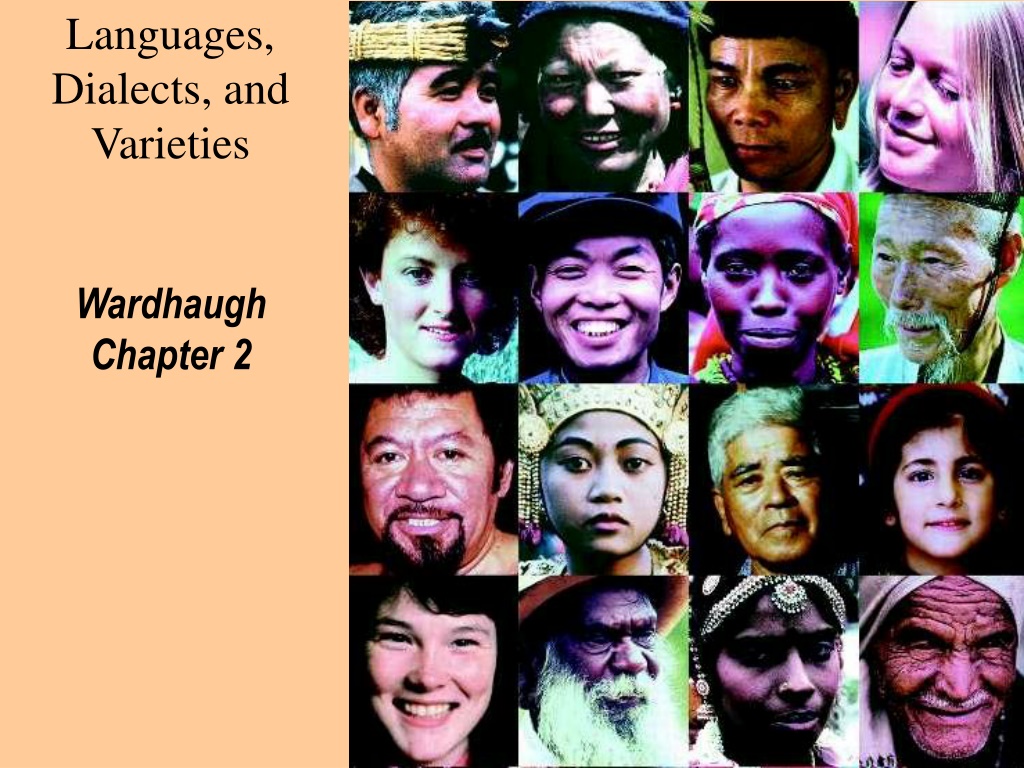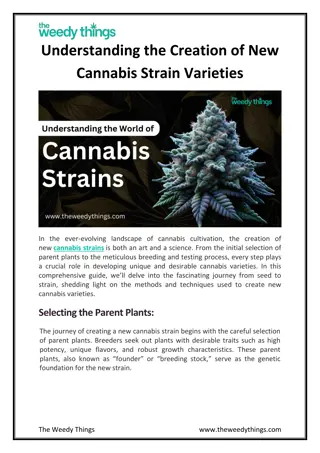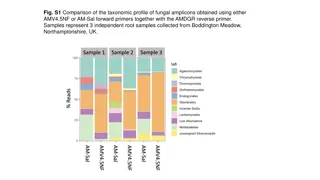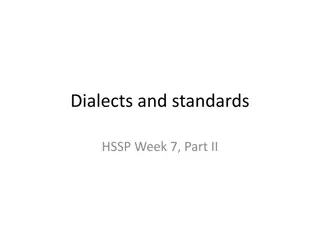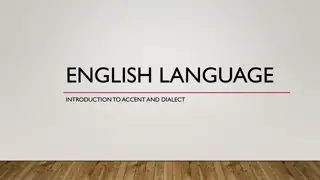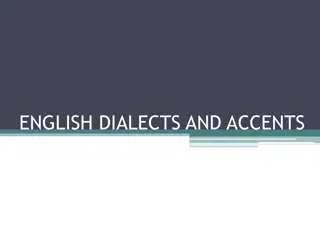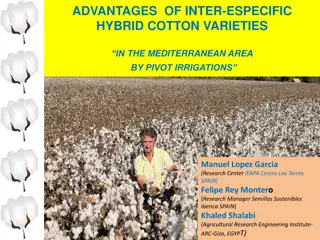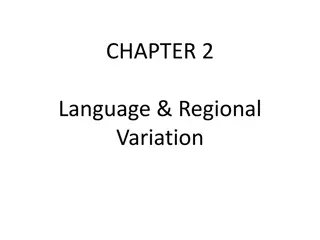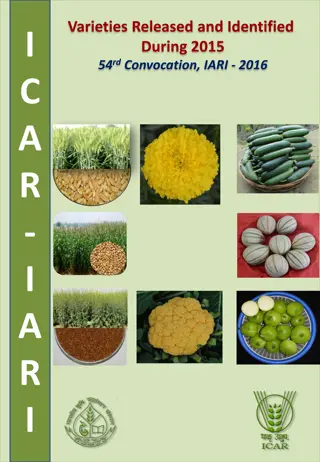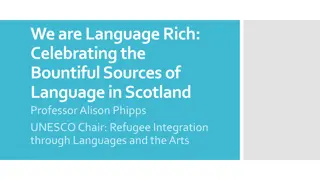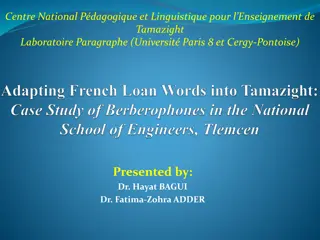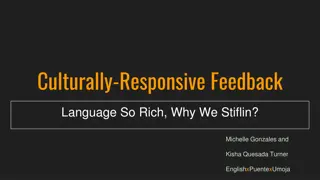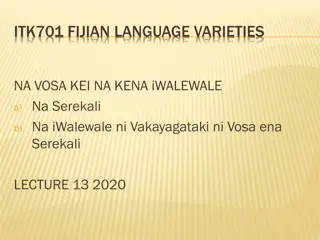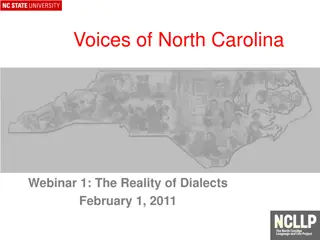Understanding Language, Dialects, and Varieties: Exploring Linguistic Diversity
Explore the nuances between language, dialects, and varieties as discussed in Wardhaugh's Chapter 2. Unravel the complexities of how language relates to ethnicity and social identity, and dive into the distinctions between vernaculars and standardized forms of language. Delve into the ambiguity of terms such as dialect and the varying perceptions attached to them in different cultural contexts.
Download Presentation

Please find below an Image/Link to download the presentation.
The content on the website is provided AS IS for your information and personal use only. It may not be sold, licensed, or shared on other websites without obtaining consent from the author. Download presentation by click this link. If you encounter any issues during the download, it is possible that the publisher has removed the file from their server.
E N D
Presentation Transcript
Languages, Dialects, and Varieties Wardhaugh Chapter 2
What is the difference between language and dialect? Variety is a term used for to replace both terms - Hudson says a set of linguistic items with similar distribution Variety is some linguistic shared items which can uniquely be associated with some social items
For many people there can be no confusion at all about what language they speak. For example, they are Chinese, Japanese, or Korean and they speak Chinese, Japanese, and Korean respectively. It is as simple as that; language and ethnicity are virtually synonymous Languages named by people are not only ascribed by region, which is what we might expect, but sometimes also by caste, religion, village, and so on. Moreover, they can change from census to census as the political and social climate of the country changes.
What are the essential differences between a language and a dialect? Haugen (1966a) has pointed out that language and dialect are ambiguous terms. Ordinary people use these terms quite freely in speech; for them a dialect is almost certainly no more than a local non-prestigious (therefore powerless) variety of a real language. In contrast, scholars often experience considerable difficulty in deciding whether one term should be used rather than the other in certain situations.
Dialect is used both for local varieties of English, e.g., Yorkshire dialect, and for various types of informal, lower-class, or rural speech. Linguists use the term vernacular to refer to the language a person grows up with and uses in everyday life in ordinary, commonplace, social interactions. We should note that so-called vernaculars may meet with social disapproval from others who favor another variety, especially if they favor a variety heavily influenced by the written form of the language. Therefore, this term often has pejorative associations when used in public discourse.
The situation is further confused by the distinction the French make between un dialecte and un patois. dialecte is a regional variety of a language that has an associated literary tradition, whereas patois is a regional variety that lacks such a literary tradition. used pejoratively; it is regarded as something less than a dialect because of its lack of an associated literature.
What is the difference between language and dialect? There are a lot of situations that show language versus dialect isn t clear Chinese Norwegian/Swedish Croatian and Serbian Hebrew Arabic Hindi / Urdu
The commonly cited criterion used to determine if two varieties are dialects of the same language or distinct languages is that of mutual intelligibility: If speakers can understand each other, they are speaking dialects of the same language; if they cannot, they are speaking different languages. Some speakers of (standard) German can understand (standard) Dutch, while incomprehensible. others may find it
Hindi and Urdu are considered by linguists to be the same language in its spoken form, but one in which certain differences are becoming more and more magnified for political and religious reasons in the quest to establish different national identities. Hindi is written left to right in the Devanagari script, whereas Urdu is written right to left in the Arabic Persian script. Hindi draws on Sanskrit for its borrowings, but Urdu draws on Arabic and Persian sources. Large religious and political differences make much of small linguistic differences.
The difference between language and dialect Need to discuss issues of solidarity and power How do these play into the definitions of a variety as a dialect or language? A language is a dialect with an army and a navy Power requires some kind of asymmetrical relationship between entities: one has more of something that is important, e.g. status, money, influence, etc., than the other or others. A language has more power than any of its dialects. It is the powerful dialect but it has become so because of nonlinguistic factors. Standard English and Parisian French are good examples.
Dialect at one time indicated a geographical as well as linguistic distinction
Dialect continuum One definition of dialect is a mutually intelligible variety of a language. A continuum exists in geography if you travel from NW France to SE Italy or SW Spain - all related languages. Each adjacent village can understand each other regardless of where the political borders are. BUT Paris, Madrid and Rome speak varieties that are not mutually intelligible, therefore separate languages
Solidarity, on the other hand, is a feeling of equality that people have with oneanother. They have a common interest around which they will bond. A feeling of solidarity can lead people to preserve a local dialect or an endangered language to resist power, or to insist on independence. It accounts for the persistence of local dialects, the modernization of Hebrew, and the separation of Serbo- Croatian into Serbian and Croatian.
standardization Codification of language: grammars, spelling books, dictionaries, literature. We can often associate specific items or events with standardization, e.g., Wycliffe s and Luther s translations of the Bible into English and German, respectively, Caxton s establishment of printing in England, and Dr Johnson s dictionary of English published in 1755.
Standardization also requires that a measure of agreement be achieved about what is in the language and what is not. Once a language is standardized it becomes possible to teach it in a deliberate manner. It takes on ideological dimensions social, cultural, and sometimes political beyond the purely linguistic ones.
Standard English is that variety of English which is usually used in print, and which is normally taught in schools and to non-native speakers learning the language. It is also the variety which is normally spoken by educated people and used in news broadcasts and other similar situations. The difference between standard and nonstandard, it should be noted, has nothing in principle to do with differences between formal and colloquial language, or with concepts such as bad language. Standard English has colloquial as well as formal variants, and Standard English speakers swear as much as others.
What is Standard English Variety which is: In most print sources? Taught in schools? The version ESL students study?
People without university educations tend to think of their speech and grammar as inferior. They believe pundits who tell them about proper grammar and speech.
Regional Dialects Regional variation in the way a language is spoken is likely to provide one of the easiest ways of observing variety in language. As you travel throughout a wide geographical area in which a language is spoken, and particularly if that language has been spoken in that area for many hundreds of years, you are almost certain to notice differences in pronunciation, in the choices and forms
